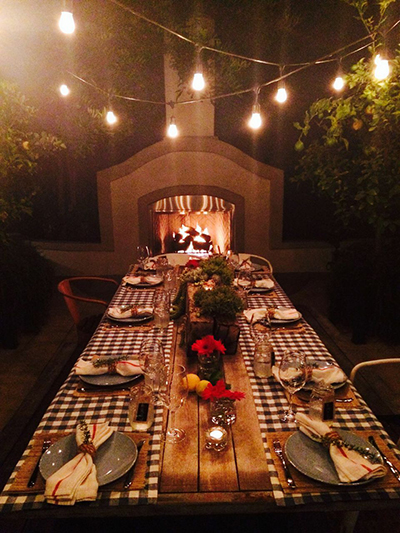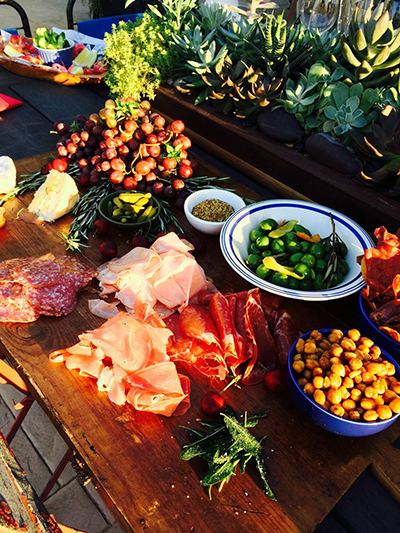And the Oscar goes to... NPH a Dinner Party
/I had the pleasure of cooking for the 2015 Oscar Host at a small dinner party the other night. Neil Patrick Harris and his partner David Burka were in town promoting Neil's new book.
Read MoreI had the pleasure of cooking for the 2015 Oscar Host at a small dinner party the other night. Neil Patrick Harris and his partner David Burka were in town promoting Neil's new book.
Read MoreI love seafood, and just because its fall doesn’t mean lobster and crab rolls have to wait til next summer. I've become obsessed with making crab rolls with salt & vinegar potato chips. It's as easy as one, two, three.
Read MoreA lovely alfresco dinner with a roaring fire, lights over the table on a dimmer from Target. A checked table runner was used on the sides with the wood showing down the middle with simple gerber daisies in ball jars. Also I used a ball jar for the water on the table that had place cards attached. A brown tag with chalkboard paint. The lemons we got from the clients lemon trees as well as the rosemary placed on top of the napkin.

We put a big board out filled with cheeses, meats , olives, chickpeas, mustards, cornichons, baked proscuitto. I think adding herbs (note the rosemary around the grapes) it just takes it up a notch. I love honey and doused some of the St. Angel cheese which is crazy delicious that I got at whole foods.

The Olives we put in a small sauce pan and covered them with olive oil , lemon and clementine strips and some hot chile fakes. Brought to a boil and turned off. Let cool and poured the olives into a bowl with a little of the oil, the chili flakes , and lemon & clementine rind with a sprig of rosemary. The rest of the olive oil we set out with some grilled bread and people used it to dip there bread in.
I love fried sage sprinkled with salt. I could eat it like potato chips and that is what I did here on the corner of the board. In the blue bowl is baked chick peas which are delicious to eat like some nuts. Drain and rinse off the chickpeas. Dry on paper towel. Put on a cookie sheet with a little olive oil cumin, salt and pepper at 400 degrees for 15 minutes. Shake after 7 minutes. Everyones oven is different so cook them until you think they are crispy enough.
The different meats, I had them slice at whole food. Very thin. The tomato crostini were grilled bread with buratta,roasted tomatoes (which I roasted baby tomatoes for 25 minutes at 350 degrees with a little olive oil salt and pepper. Took out and let cool.) sprinkled with torn basil and sprinkled with malt on salt flakes, balsamic demi glaze.
This was a rose party where they tried all different kind of Rose’s. The host wanted to put out a little tequila bar for those who may have not wanted Rose. Which I thought was fun and all the guests seemed to sip tequila and enjoy trying all the different roses.
Today is National Coq Au Vin Day! For those who don't know Coq Au Vin is a traditional French dish of braised chicken in red wine, traditionally Burgundy. It's a dish Julia Child cooked frequently and helped increase the dish's exposure and popularity.
In honor of the late, great Julia Child I'm using her recipe to make Coq Au Vin for the family tonight.
Ingredients
Cooking Directions Browning and simmering the chicken. Before browning the chicken, sauté the blanched bacon or salt pork and remove to a side dish, leaving the fat in the pan. Brown the chicken in the pork fat, adding a little olive oil, if needed. Flame the chicken with the brandy, if you wish -- it does give its own special flavor, besides being fun to do. Then proceed to simmer the chicken in the wine, stock, tomatoes and seasoning as directed in the master recipe.
Finishing the dish. Strain, degrease, and finish the sauce, also as described. Strew the braised onions and sautéed mushrooms over the chicken, baste with the sauce, and simmer a few minutes, basting, to rewarm the chicken and to blend flavors. Special note: To blanch bacon or salt pork: When you use bacon or salt pork in cooking, you want to remove its salt as well as its smoky flavor, which would permeate the rest of the food. To do so, you blanch it -- meaning, you drop it into a saucepan of cold water to cover it by 2 to 3 inches, bring it to the boil, and simmer 5 to 8 minutes; the drain, refresh in cold water, and pat dry in paper towels.
St. Francis’ Cranberry Sauce
Makes approximately 3 cups
Chunk up the pears, peeled oranges and apples. Add the wine and limeade to medium saucepan and bring to a boil. Add the cranberries and the chunked up fruit along with the fresh ginger and cinnamon. Stir continually for 5 minutes and then reduce heat to a simmer. Continue stirring until the sauce is thickened to your liking. Turn off heat. Fold in apricot jam and let cool.
Tips:
Great to store in a canning jar.
Option:
Use marmalade if you do not have apricot jam.
This is my buddy Chris' amazing recipe for simple Clams and Linguine **No shrimp.
Start out by taking your steak out of the fridge a half an hour before you plan to prepare it. Plunking ice-cold meat onto a hot pan will get you a piece of pot roast rather than a nicely seared sirloin. Generously shower the meat with salt and pepper, shower, not sprinkle being the key word here (come on, you’ve seen chefs do it on the Food Network, so don’t be a spice wimp, really lay it on). Seasoning the steak beforehand means the spices will mingle with the juices of the meat as it cooks, resulting in a much fuller and satisfying flavor, so there is a method to this apparent salt-madness.
Preheat your pan over medium heat. A heavy-gauge pan works best, as the heat will be distributed over the surface evenly, without the hotspots that might scorch your meat. Pat the steak dry with paper towels and rub it all over with olive oil. This accomplishes two things. A steak with surface moisture will simply steam when it’s placed in a hot pan and the oil helps by transferring heat directly from the pan to the meat fibers (oil being a very efficient conductor of heat)
Now here is the part where people are going to look at you funny – start by standing the steak on it’s narrow side. That’s right, you’ll probably have to hold it up with tongs, but this step renders some of the beef fat while crisping it up at the same time. Brown all the fatty sides of the steak before laying it flat. Not only will the finished steak look more appetizing, but it’s now going to cook in its own flavorful fat, a rather perfect synthesis of meat methodology if you ask me.
Now that the steak is laying flat, let it cook on one side for about five minutes before turning it. Remember, you’re using medium heat here and caramelization, not carbonization, is what you are after. Occasionally tilt the pan, spoon up some of the rendered beef fat and baste the meat. After the steak has cooked for a full five minutes on each side, flip it frequently, about every minute, until it’s done to your likeness. Constant turning keeps the juices from congregating on the surface of the meat (juices that evaporate with an agonizing hiss as they hit the pan) and results in a juicer steak.
Remove the steak to a cooling or roasting rack, and poise a plate beneath to catch any juices. Simply plating the meat would result in the bottom steaming in its juices as it cools, and some of that precious caramelization that you’ve taken so many steps to achieve would be lost. Let the steak rest a good ten minutes before serving. Be sure to include any juices you’ve captured, and if deglazing a pan is in your repertoire, don’t forget the pan sauce.
Serves 4
For Salmon
For Sauces
Marinate salmon:
Stir together mirin, soy sauce, vinegar, and ginger in a shallow dish. Add fish, skin side up. Marinate covered, at room temperature 10 minutes. Preheat broiler.
Make sauces:
Boil soy sauce, honey, and lime juice in a small saucepan, stirring frequently, until thickened, about 4 minutes.
Stir together wasabi powder and water in a small bowl. Sauces can be made 2 hours ahead and kept, covered at room temperature.
Broil fish, skin side down, on oiled rack of a broiler pan or cookie sheet until fish is just cooked through, about 6 minutes or bake at 400˚ F for 10 minutes.
Serve salmon drizzled with sauces.
